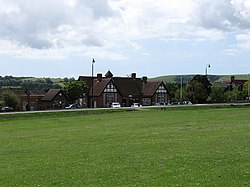Ringmer
| Ringmer | |
|---|---|
 |
|
| Ringmer shown within East Sussex | |
| Area | 25.9 km2 (10.0 sq mi) |
| Population | 4,648 (Parish-2011) |
| • Density | 459/sq mi (177/km2) |
| OS grid reference | TQ445124 |
| • London | 43 miles (69 km) N |
| District | |
| Shire county | |
| Region | |
| Country | England |
| Sovereign state | United Kingdom |
| Post town | LEWES |
| Postcode district | BN8 |
| Dialling code | 01273 |
| Police | Sussex |
| Fire | East Sussex |
| Ambulance | South East Coast |
| EU Parliament | South East England |
| UK Parliament | |
| Website | Ringmer Parish Council |
Ringmer is a village and civil parish in the Lewes District of East Sussex, England. The village is located 3 miles (4.8 km) east of Lewes. Other small settlements in the parish include Upper Wellingham, Ashton Green, Broyle Side, Little Norlington and Shortgate.
Ringmer is one of the largest villages in the south of England. There has been human habitation since at least Roman times. The village church, dedicated to St Mary, was probably built in the 13th century. One of its rectors, named to the living in 1533, was William Levett, named in the same year as rector of Buxted, and one of the most improbable figures in English ecclesiastical history.
Ringmer has two schools, Ringmer Primary School for ages 4–11 and Ringmer Community College for students aged 11–18. Ringmer Community College houses the local swimming pool which is run by Wave Leisure.
The symbol of Ringmer is a tortoise named Timothy, after the female tortoise that the naturalist Gilbert White carried back to Selborne in Hampshire in 1780. White’s aunt Rebecca Snooke lived in Delves House where Timothy had the run of the courtyard garden. Timothy died in 1794, a year after Gilbert White.
Ringmer is part of the electoral ward called Ouse Valley and Ringmer. the population of this ward at the 2011 census was 6,422.
Ringmer Mill stood for centuries on Mill Plain overlooking Ringmer. This post mill was in operation until 1921 but collapsed in 1925 leaving the mill post, on which the body of the mill rotated, remaining as a local landmark.
Plashett Park Wood is a Site of Special Scientific Interest partly in the parish. It is a site of biological importance as an area of ancient woodland. Plashett Wood and the adjolining Plashett Park Farm provide habitats for a wide variety of breeding birds and bats, plus a number of rarer invertebrates and flora.
...
Wikipedia

